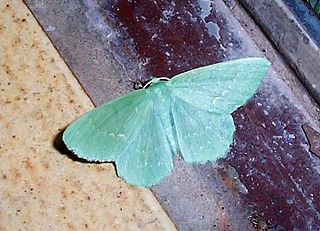
The large emerald is a moth which is the type species for the family Geometridae. It is found throughout the Palearctic region and the Near East in and around deciduous forests, heathlands, marshland and in settlements close to woodland. The species was first described by Carl Linnaeus in his 1758 10th edition of Systema Naturae.

The common white wave is a moth of the family Geometridae. The species was first described by Carl Linnaeus in his 1758 10th edition of Systema Naturae. It is found throughout the Palearctic region .The habitat is deciduous forests and their surroundings.
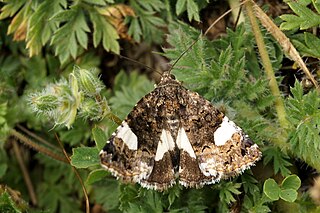
Tyta luctuosa is a noctuid ("owlet") moth. Its common names include four-spotted moth and field bindweed moth. It is the only member of the genus Tyta, which belongs to the Metoponiinae subfamily. The species was first described by Michael Denis and Ignaz Schiffermüller in 1775. The genus was erected by Gustaf Johan Billberg in 1820.

The herald is a moth of the family Erebidae. The species was first described by Carl Linnaeus in his 1758 10th edition of Systema Naturae. It is found throughout the Palearctic and Nearctic (Holarctic).
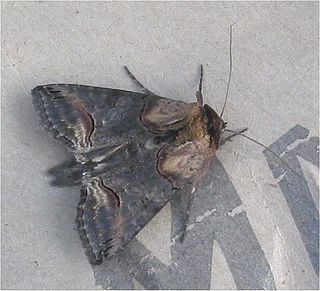
Abrostola triplasia is a moth of the family Noctuidae. It is found across the entire Palearctic realm. Subarctic territories with an average temperature of below 6 °C are an exception. In the warmest and driest regions of the Mediterranean, the Middle East, and the mountains in West and Central Asia, the species occurs only scattered or is entirely lacking.

Orthosia incerta, the clouded drab, is a species of moth of the family Noctuidae, found in Europe and Asia. The occurrence of the species extends through all European countries through the Palearctic to the Russian Far East and Japan. It is absent from northern Fennoscandia and in the Alps it occurs up to 2000 m above sea level.

Hoplodrina blanda is a moth of the family Noctuidae. It is found in the Palearctic realm.

Eublemma anachoresis, the banner, is a moth of the family Erebidae. The species was first described by Hans Daniel Johan Wallengren in 1863. It is found in the Indomalayan realm, Australia and the southern part of Africa. Records include Fiji, Hong Kong, India, Sri Lanka, Japan, the Society Islands, Eswatini, Taiwan, Thailand and northern New South Wales and Queensland in Australia.

Caradrina clavipalpis, the pale mottled willow, is a moth of the family Noctuidae. The species was first described by Giovanni Antonio Scopoli in his 1763 Entomologia Carniolica. It is found in the Palearctic realm. It is an introduced species in North America, where it was first reported from Queens in New York City in 1993. In 2009 it was found in Rochester, New York, so it appears to be established and spreading.
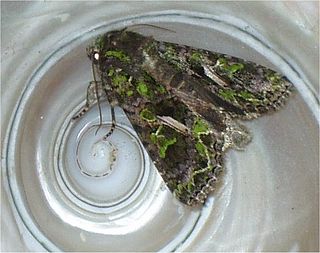
The Orache Moth(Trachea atriplicis) is a species of moth of the family Noctuidae. It is found in all of Europe, east across the Palearctic to the Pacific Ocean and Japan.

Deilephila porcellus, the small elephant hawk-moth, is a moth of the family Sphingidae. The species was first described by Carl Linnaeus in his 1758 10th edition of Systema Naturae.

Anaplectoides prasina is a species of moth of the family Noctuidae. It is found in both the Palearctic and Nearctic realms.

Gracillaria syringella is a moth of the family Gracillariidae. It is found in Europe. It has been introduced in North America.

Mythimna straminea, the southern wainscot, is a moth of the family Noctuidae. The species was first described by Georg Friedrich Treitschke in 1825. It is found in the western parts of the Palearctic realm, including Morocco, Europe, Turkey, the Caucasus, Israel, and Lebanon.

Psimada is a monotypic moth genus of the family Noctuidae. Its only species, Psimada quadripennis, is found in the Indian subregion, southern China, Taiwan, Myanmar, Thailand, Sri Lanka, the Andaman Islands, Sundaland, Sulawesi and Seram. Both the genus and species were first described by Francis Walker in 1858.

Recurvaria leucatella is a moth of the family Gelechiidae. It is found in most of Europe, Turkey, Central Asia and the Caucasus.

Abrostola asclepiadis is a moth of the family Noctuidae. It is found in South and Central Europe as far north as Finland and Sweden, Asia Minor and the Caucasus.

Hadena confusa, the marbled coronet, is a species of moth of the family Noctuidae. It is found in Europe, North Africa and West Asia and Central Asia.

Bucculatrix cidarella is a moth of the family Bucculatricidae. It is found in most of Europe, Kazakhstan and Japan (Honshu). It was described in 1839 by Philipp Christoph Zeller.
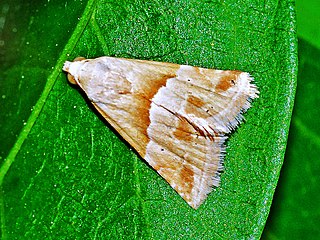
Eublemma parva, the small marbled, is a moth of the family Erebidae. The species was first described by Jacob Hübner in 1808.


















